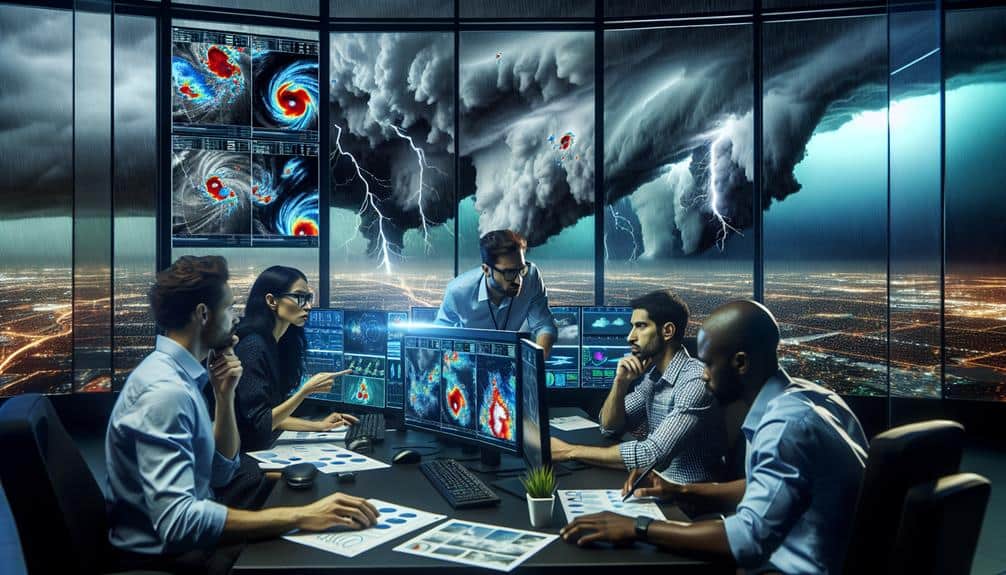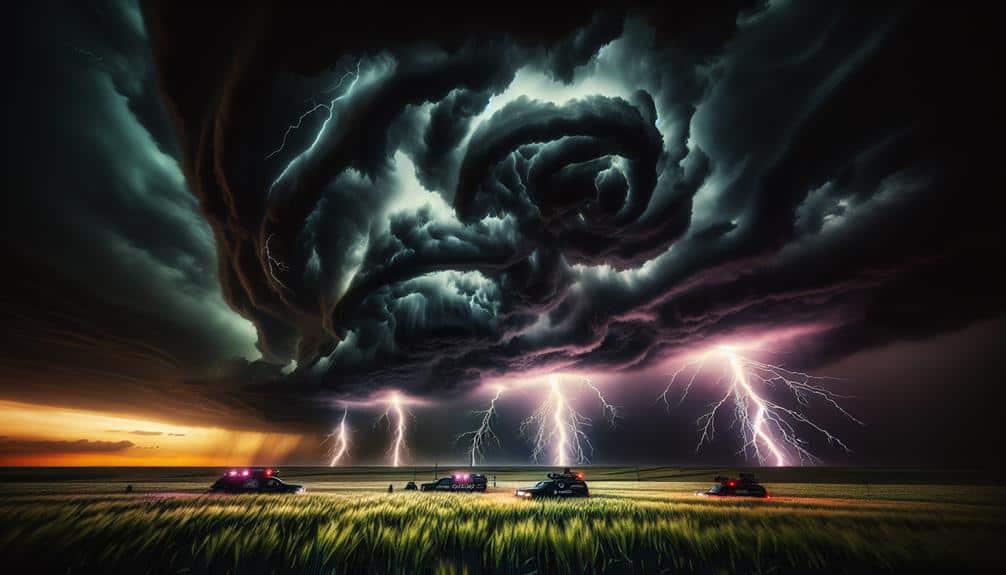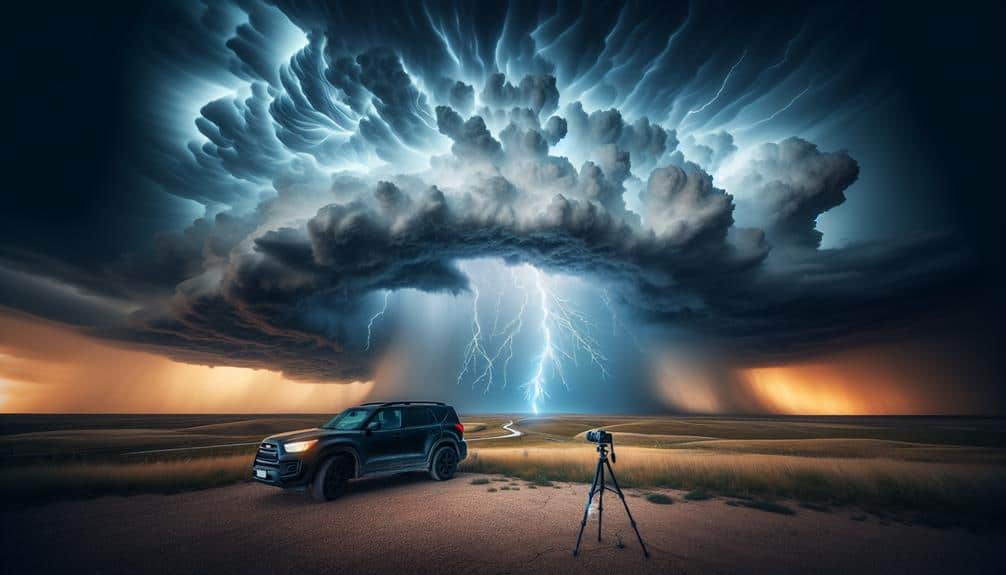We need to master meteorological tools like radar and satellite imagery to anticipate weather changes accurately. Optimizing our equipment, from anemometers to cameras, and ensuring our gear is reliable and well-maintained, is critical. Prioritizing safety protocols—through thorough risk assessment and route planning—keeps us safe. Effective team coordination, emphasized through drills and communication strategies, can't be overlooked. Finally, scrutinizing past competitions gives us valuable insights into what worked and what didn't. By analyzing these elements, we gain the edge required to dominate storm chasing competitions and elevate our performance further.
Key Points
- Master weather radar and satellite imagery to anticipate storm developments accurately.
- Invest in high-quality, durable equipment and ensure all devices are tested and reliable.
- Prioritize safety protocols with risk assessments, emergency preparedness, and reliable communication channels.
- Enhance team coordination through effective communication strategies, role clarity, and practice drills.
Master Meteorological Tools
Mastering meteorological tools is essential for any storm chaser aiming to predict severe weather patterns accurately and stay safe in the field. When we're out there chasing storms, we rely heavily on weather radar and satellite imagery to make informed decisions. These tools are our lifelines, providing real-time data on storm developments and potential hazards.
Weather radar, for example, helps us track precipitation intensity, storm structure, and movement. By analyzing radar data, we can identify supercells, tornadoes, and other severe phenomena. It's all about interpreting those radar returns: bright reds and greens indicating rotation, while hook echoes suggest possible tornado formation. Knowing how to read and respond to these signals can be the difference between a successful chase and a dangerous encounter.
Satellite imagery complements radar by offering a broader perspective. It enables us to monitor cloud formations, temperature gradients, and moisture levels. High-resolution images from satellites like GOES-16 provide critical insights into storm dynamics and evolution. By combining radar data with satellite imagery, we gain a thorough understanding of weather systems, allowing us to anticipate changes and react swiftly.
Together, these tools empower us to chase storms with precision, harnessing our knowledge to experience the thrill while ensuring our safety.
Optimize Your Equipment
To truly excel in storm chasing, we need to optimize our equipment to make certain it's both reliable and suited for the extreme conditions we face. It's not just about having the latest gadgets; it's about making certain our gear can withstand the rigors of unpredictable weather.
First, let's upgrade gear that's outdated or prone to failure. Investing in a high-quality anemometer, robust cameras with weatherproof housings, and durable GPS units can make all the difference.
Next, let's refine our practice techniques. We should regularly test our equipment in various conditions, ensuring we understand how each piece performs under stress. This hands-on familiarity minimizes surprises when we're out in the field. It also helps in identifying any weak points that need addressing before we're in the thick of a storm.
Additionally, let's not forget the importance of reliable power sources. Portable, high-capacity power banks and backup batteries are essential, making certain our devices stay operational when we need them most.
Prioritize Safety Protocols
Securing our safety in the field starts with developing and adhering to stringent safety protocols that address the unpredictable nature of storm chasing.
First and foremost, emergency preparedness is non-negotiable. We need a well-stocked emergency kit—complete with first aid supplies, flashlights, and backup batteries.
Risk assessment is critical before we even hit the road. We must evaluate potential threats, from flash floods to tornadoes, and determine our safest routes and exit strategies.
Effective communication strategies can't be overlooked. We should establish reliable channels, such as two-way radios and mobile apps, to stay connected with our team and local authorities. Regular check-ins ensure everyone is accounted for and aware of any sudden changes in weather conditions.
Speaking of weather, maintaining a high level of weather awareness is essential. Constantly monitoring weather updates, radar data, and storm models allows us to make informed decisions and avoid hazardous situations.
Develop Team Coordination
With our safety protocols firmly in place, we must now focus on developing seamless team coordination to efficiently track and document storm activity. Effective communication strategies are crucial. We need to make sure everyone on the team knows their role and can relay critical information quickly. This becomes particularly important when executing our emergency response plan.
To enhance our coordination, we'll engage in team-building exercises that simulate real-life storm chasing scenarios. These drills won't only improve our reflexes but also build trust among team members.
In preparation for any storm, our forecast analysis must be exceptional. By understanding weather patterns and potential storm paths, we can strategize our actions and allocate resources more effectively. Here's how we can deepen our coordination:
- Weekly Briefings: Regularly scheduled meetings to discuss upcoming storm potentials and review past performances.
- Role Clarity: Each member should have a clear understanding of their responsibilities during a chase.
- Real-time Communication Tools: Utilize advanced communication systems to stay connected during high-pressure moments.
Analyze Previous Competitions

By examining the outcomes and strategies of previous storm chasing competitions, we can identify key factors that contributed to both successes and failures. It's essential to study trends from past events, noting which approaches yielded the best results and which fell flat. This means diving into data, reviewing strategies that led to high scores, and understanding the conditions that influenced performance.
We should assess competitors by looking at their strengths and weaknesses. What equipment did they use? How did they plan their routes? By dissecting these elements, we can adjust our tactics to outperform them. For example, if a winning team employed advanced radar technology, we should consider upgrading our own gear. Alternatively, if a competitor failed due to poor communication, we can focus on enhancing our team's coordination.
Reviewing strategies from past competitions also allows us to spot common pitfalls. Were there consistent issues with timing or location accuracy? By identifying these, we can implement measures to avoid them.
Ultimately, our goal is to learn from every past competition, continuously refining our approach to become more flexible and effective. This level of preparedness will offer us the freedom to chase storms with confidence and precision.
Frequently Asked Questions
What Types of Vehicles Are Best for Storm Chasing Competitions?
When considering what types of vehicles are best, we should prioritize off-road capabilities and moderate vehicle size. Larger vehicles can be cumbersome, while smaller ones might lack durability. A balanced, rugged SUV usually fits the bill for our adventures.
How Can I Get Sponsorships for My Storm Chasing Team?
We should focus on sponsorship strategies by leveraging networking opportunities and effective marketing tactics. Building strong team branding will attract sponsors who value our expertise and passion, ensuring we secure the support needed for our storm chasing endeavors.
What Are the Top Apps for Real-Time Storm Tracking?
Imagine standing under a turbulent sky, feeling the raw power of nature. For storm tracking accuracy and live updates, we'd recommend RadarScope, Storm Radar, and MyRadar. These apps provide precise, real-time data, enhancing our storm chasing adventures.
How Do Storm Chasers Stay Motivated During Long Competitions?
We stay motivated during long competitions through mental preparation and endurance. Team camaraderie and support keep our spirits high. We thrive on the challenge and freedom of the chase, always pushing ourselves to capture the perfect storm.
What Kind of Insurance Do Storm Chasers Need?
Moving through storms is like dancing with danger; we need solid coverage options and robust liability protection. All-encompassing auto insurance, health insurance, and specialized storm chasing insurance guarantee we're protected from the unpredictable nature of our thrilling pursuit.


